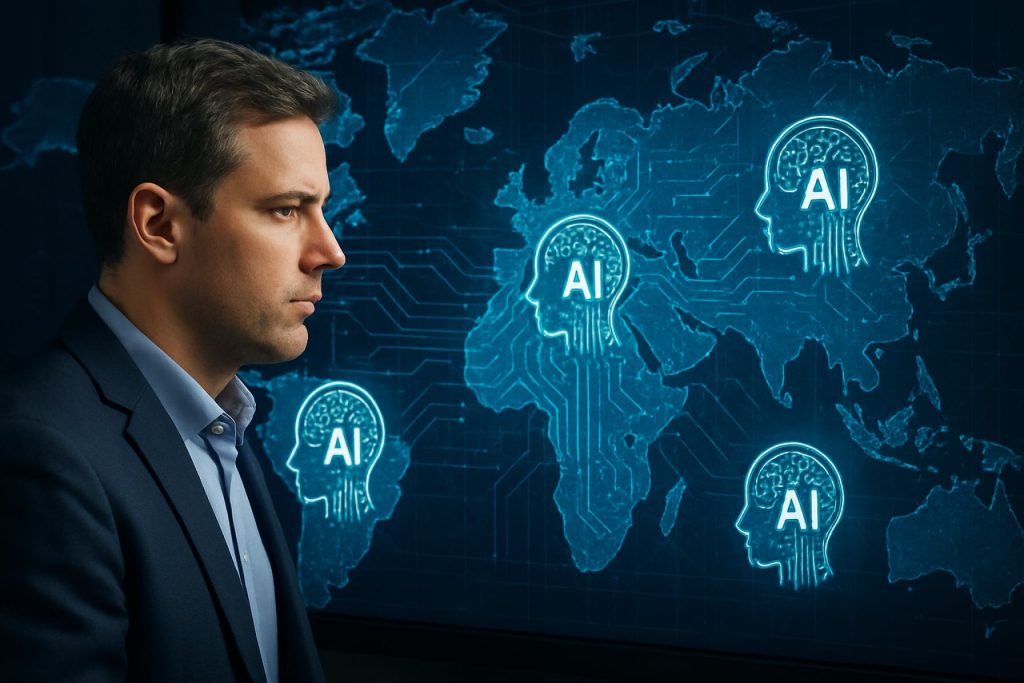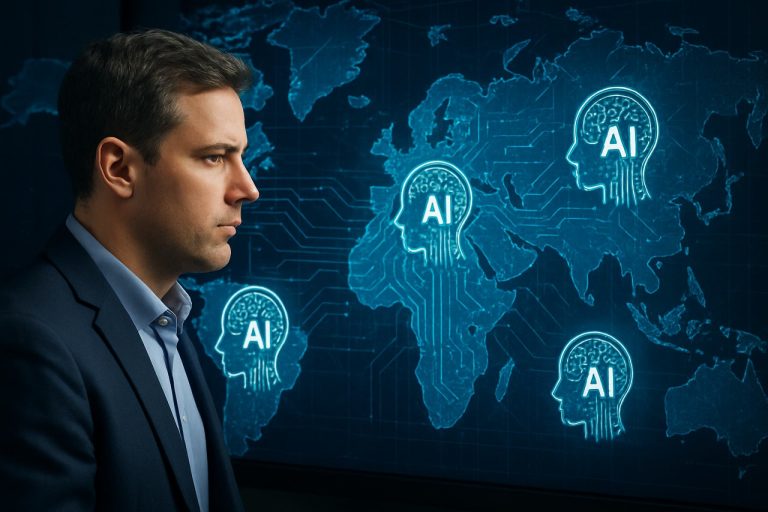
Unveiling the Next Wave: How Artificial Intelligence is Reshaping Global Industries
- AI Market Landscape and Key Drivers
- Innovations and Breakthroughs in AI Technologies
- Major Players and Shifting Competitive Dynamics
- Projected Growth and Investment Hotspots
- Geographic Trends and Regional Adoption
- Anticipated Developments and Strategic Directions
- Barriers, Risks, and Emerging Opportunities
- Sources & References
“Artificial Intelligence (AI) is entering an era of explosive growth and widespread adoption.” (source)
AI Market Landscape and Key Drivers
The global adoption of artificial intelligence (AI) is accelerating rapidly, with projections indicating a transformative impact across industries between 2025 and 2030. According to McKinsey, AI adoption rates among organizations have more than doubled since 2017, and this momentum is expected to continue as generative AI and machine learning technologies mature. By 2030, the global AI market is forecasted to reach $1.8 trillion, up from $241 billion in 2023, reflecting a compound annual growth rate (CAGR) of over 35%.
Key sectors driving this adoption include healthcare, finance, retail, manufacturing, and transportation. In healthcare, AI is revolutionizing diagnostics, drug discovery, and patient care management. The financial sector is leveraging AI for fraud detection, algorithmic trading, and personalized banking services. Retailers are utilizing AI for demand forecasting, inventory management, and customer experience personalization. Manufacturing is seeing increased use of AI-powered robotics and predictive maintenance, while transportation is advancing with autonomous vehicles and smart logistics (PwC).
Several key drivers are fueling this global trend:
- Advancements in Generative AI: The rise of large language models and generative AI tools is enabling new applications in content creation, coding, and design, making AI more accessible to non-technical users (Gartner).
- Data Proliferation: The exponential growth of data from IoT devices, social media, and enterprise systems is providing the raw material needed for AI algorithms to deliver actionable insights.
- Cloud Computing: The widespread availability of cloud-based AI platforms is lowering barriers to entry, enabling organizations of all sizes to deploy AI solutions at scale.
- Government Initiatives: National AI strategies and increased public investment, particularly in the US, China, and the EU, are fostering innovation and adoption (European Commission).
Looking ahead, AI adoption is expected to become ubiquitous, with organizations focusing on responsible AI, workforce upskilling, and integration with emerging technologies such as quantum computing and edge AI. The next five years will be pivotal in shaping the competitive landscape and societal impact of AI worldwide.
Innovations and Breakthroughs in AI Technologies
The global adoption of artificial intelligence (AI) technologies is accelerating rapidly, with projections indicating transformative impacts across industries between 2025 and 2030. As organizations seek to leverage AI for competitive advantage, several key trends are emerging that define the next phase of AI integration worldwide.
- Widespread Enterprise Integration: By 2025, over 80% of enterprises are expected to have adopted AI in some form, with a focus on automating business processes, enhancing customer experiences, and optimizing supply chains (Gartner). This trend is driven by the maturation of AI platforms and the proliferation of user-friendly AI tools.
- Generative AI Expansion: Generative AI, such as large language models and image generators, is expected to account for a significant share of AI investments. According to McKinsey, generative AI could add up to $4.4 trillion annually to the global economy by 2030, revolutionizing content creation, software development, and design.
- AI Democratization: The availability of cloud-based AI services and open-source frameworks is lowering barriers to entry, enabling small and medium-sized enterprises (SMEs) and emerging markets to adopt AI solutions. This democratization is expected to drive a surge in AI-powered startups and innovations, particularly in Asia-Pacific and Latin America (Deloitte).
- Sector-Specific Breakthroughs: Healthcare, finance, manufacturing, and retail are leading sectors in AI adoption. For example, AI-driven diagnostics and personalized medicine are projected to improve patient outcomes and reduce costs, while AI in finance is enhancing fraud detection and risk management (PwC).
- Regulatory and Ethical Considerations: As AI adoption grows, governments are introducing regulations to address ethical concerns, data privacy, and algorithmic transparency. The European Union’s AI Act, expected to be enforced by 2026, will set global benchmarks for responsible AI deployment (EU AI Act).
In summary, the period from 2025 to 2030 will witness unprecedented global AI adoption, characterized by technological breakthroughs, economic impact, and evolving regulatory landscapes. Organizations that strategically embrace these trends will be well-positioned to thrive in the AI-driven future.
Major Players and Shifting Competitive Dynamics
The global landscape for artificial intelligence (AI) adoption is rapidly evolving, with major technology companies and emerging players driving innovation and competition. Between 2025 and 2030, AI is expected to become deeply integrated across industries, reshaping competitive dynamics and market leadership.
- Tech Giants Lead the Charge: Companies such as Microsoft, Google, IBM, and Amazon Web Services continue to dominate the AI market. Their investments in cloud-based AI platforms, large language models, and enterprise solutions are setting industry standards. According to Gartner, the global AI software market is projected to reach $297 billion by 2027, with these players capturing a significant share.
- Rise of Regional and Niche Players: In Asia, companies like Baidu, SenseTime, and Huawei are accelerating AI adoption, particularly in smart cities, healthcare, and autonomous vehicles. Europe is witnessing increased activity from firms such as Siemens and SAP, focusing on industrial AI and enterprise automation.
- Startups and Open-Source Disruptors: The proliferation of open-source AI models and startups is intensifying competition. Companies like OpenAI and Anthropic are challenging incumbents with innovative generative AI solutions. According to CB Insights, global AI startup funding reached $50 billion in 2023, signaling robust momentum for new entrants.
- Shifting Competitive Dynamics: The next five years will see increased collaboration between traditional enterprises and AI specialists, as well as a surge in cross-border partnerships. Regulatory developments, such as the EU AI Act (source), are also shaping competitive strategies, compelling companies to prioritize ethical AI and compliance.
In summary, the period from 2025 to 2030 will be marked by intensified competition, regional diversification, and a blurring of lines between established tech giants, agile startups, and sector-specific innovators. The winners will be those who can scale AI responsibly, adapt to regulatory changes, and deliver tangible business value.
Projected Growth and Investment Hotspots
The global adoption of artificial intelligence (AI) is set to accelerate significantly between 2025 and 2030, driven by advances in machine learning, natural language processing, and automation. According to McKinsey, AI adoption rates among businesses have more than doubled since 2017, and this momentum is expected to continue as organizations seek to enhance productivity, reduce costs, and unlock new revenue streams.
Market forecasts indicate robust growth: the global AI market is projected to expand from $207.9 billion in 2023 to over $1.8 trillion by 2030, reflecting a compound annual growth rate (CAGR) of 37.3% (Grand View Research). This surge is fueled by increasing investments in AI infrastructure, cloud computing, and data analytics across multiple sectors.
- North America: The United States remains the global leader in AI adoption, with significant investments in healthcare, finance, and autonomous vehicles. The region is expected to maintain its dominance, accounting for over 40% of global AI spending by 2030 (IDC).
- Asia-Pacific: China, Japan, and South Korea are rapidly scaling AI initiatives, particularly in manufacturing, smart cities, and e-commerce. China’s government aims to make the country the world’s primary AI innovation center by 2030, with projected investments exceeding $150 billion (World Economic Forum).
- Europe: The European Union is focusing on ethical AI and regulatory frameworks, while also investing in AI research and digital infrastructure. The EU’s Digital Europe Programme is allocating €2.5 billion to AI and data projects through 2027 (European Commission).
- Middle East & Africa: Countries like the UAE and Saudi Arabia are emerging as regional AI hubs, investing in smart government, energy, and logistics. The Middle East’s AI market is expected to reach $320 billion by 2030 (PwC).
Key investment hotspots include generative AI, AI-powered cybersecurity, healthcare diagnostics, and autonomous systems. As AI technologies mature, sectors such as retail, logistics, and education are also poised for rapid transformation, making global AI adoption a critical driver of economic growth through 2030.
Geographic Trends and Regional Adoption
Global AI adoption is expected to accelerate significantly between 2025 and 2030, with distinct regional trends shaping the landscape. According to McKinsey, AI adoption rates among businesses worldwide reached 55% in 2023, and projections suggest this figure could surpass 75% by 2030 as AI technologies become more accessible and integral to business operations.
- North America: The United States and Canada are poised to maintain their leadership in AI innovation and deployment. The U.S. government’s AI Bill of Rights and increased federal funding are expected to drive both public and private sector adoption. By 2030, North America is projected to account for over 35% of global AI market revenue (Statista).
- Europe: The European Union is focusing on ethical AI and regulatory frameworks, such as the AI Act, which will shape adoption patterns. While regulatory compliance may slow initial uptake, it is expected to foster trust and long-term growth. Europe’s AI market is forecast to grow at a CAGR of 28% through 2030 (GlobeNewswire).
- Asia-Pacific: China, Japan, and South Korea are rapidly scaling AI investments, with China aiming to become the global AI leader by 2030. The region is expected to see the fastest growth, with China’s AI market alone projected to reach $150 billion by 2030 (SCMP).
- Rest of the World: Latin America, the Middle East, and Africa are experiencing growing interest in AI, particularly in sectors like agriculture, healthcare, and fintech. While infrastructure and talent gaps remain, targeted investments and international partnerships are expected to drive adoption in these regions (Brookings).
Overall, global AI adoption from 2025 to 2030 will be shaped by regional priorities, regulatory environments, and investment levels, with Asia-Pacific and North America leading the charge, and Europe emphasizing responsible innovation.
Anticipated Developments and Strategic Directions
Between 2025 and 2030, global AI adoption is expected to accelerate significantly, driven by advances in generative AI, increased investment, and expanding regulatory frameworks. According to McKinsey, as of 2023, 55% of organizations had adopted AI in at least one business function, a figure projected to surpass 75% by 2027 as AI becomes more accessible and integral to business operations.
Key anticipated developments include:
- Industry-Specific AI Solutions: Sectors such as healthcare, finance, and manufacturing are expected to see tailored AI applications. For example, the global healthcare AI market is forecast to reach $188 billion by 2030, up from $11 billion in 2021 (Precedence Research).
- AI Democratization: The proliferation of low-code/no-code AI platforms will empower non-technical users, broadening adoption across small and medium-sized enterprises (Gartner).
- Regulatory Evolution: The introduction of comprehensive AI regulations, such as the EU AI Act, will shape global standards and influence adoption strategies, particularly around transparency, ethics, and data privacy (EU AI Act).
- AI-Driven Productivity Gains: By 2030, AI could contribute up to $15.7 trillion to the global economy, with productivity improvements accounting for over 55% of this impact (PwC).
- Workforce Transformation: Widespread AI adoption will necessitate large-scale workforce reskilling. The World Economic Forum estimates that 44% of workers’ core skills will change by 2027 due to AI and automation (WEF).
Strategically, organizations are expected to prioritize responsible AI deployment, invest in talent development, and form cross-industry partnerships to maximize value. The competitive landscape will increasingly favor those who can rapidly integrate AI while navigating evolving regulatory and ethical considerations. As AI matures, its role will shift from experimental to foundational, underpinning digital transformation and global economic growth.
Barriers, Risks, and Emerging Opportunities
The global adoption of artificial intelligence (AI) is accelerating, but the path from 2025 to 2030 will be shaped by a complex interplay of barriers, risks, and emerging opportunities. As organizations and governments increasingly integrate AI into core operations, understanding these dynamics is crucial for stakeholders across industries.
-
Barriers to Adoption:
- Talent Shortage: The demand for skilled AI professionals continues to outpace supply. According to the World Economic Forum, 75% of companies expect to adopt AI by 2027, but 60% cite skills gaps as a major obstacle.
- Data Privacy and Security: Stricter regulations, such as the EU’s AI Act and evolving data protection laws worldwide, are increasing compliance costs and complexity (EU AI Act).
- Infrastructure Limitations: Many regions, especially in developing economies, lack the necessary digital infrastructure to support large-scale AI deployment (ITU).
-
Risks:
- Bias and Ethical Concerns: AI systems can perpetuate or amplify biases, leading to reputational and legal risks. A 2023 IBM survey found that 85% of organizations view AI ethics as a top concern.
- Cybersecurity Threats: As AI becomes more pervasive, it also becomes a target for sophisticated cyberattacks, including data poisoning and adversarial attacks (ENISA).
- Job Displacement: Automation threatens certain job categories, with the OECD estimating that 27% of jobs are at high risk of automation by 2030.
-
Emerging Opportunities:
- Industry Transformation: Sectors such as healthcare, finance, and manufacturing are poised for significant productivity gains. The global AI market is projected to reach $826.7 billion by 2030 (Grand View Research).
- AI for Sustainability: AI-driven solutions are increasingly used to address climate change, optimize energy use, and improve resource management (UNEP).
- Global Collaboration: International partnerships and open-source initiatives are fostering innovation and helping to bridge the digital divide (OECD AI Policy Observatory).
In summary, while significant barriers and risks remain, the period from 2025 to 2030 will also see transformative opportunities as AI adoption becomes more widespread and sophisticated worldwide.
Sources & References
- Global AI Adoption Trends (2025–2030)
- McKinsey
- Statista
- PwC
- European Commission
- Deloitte
- EU AI Act
- Microsoft
- IBM survey
- Amazon Web Services
- SenseTime
- Huawei
- Siemens
- Anthropic
- Grand View Research
- IDC
- AI Bill of Rights
- GlobeNewswire
- SCMP
- Brookings
- Precedence Research
- ITU
- ENISA



